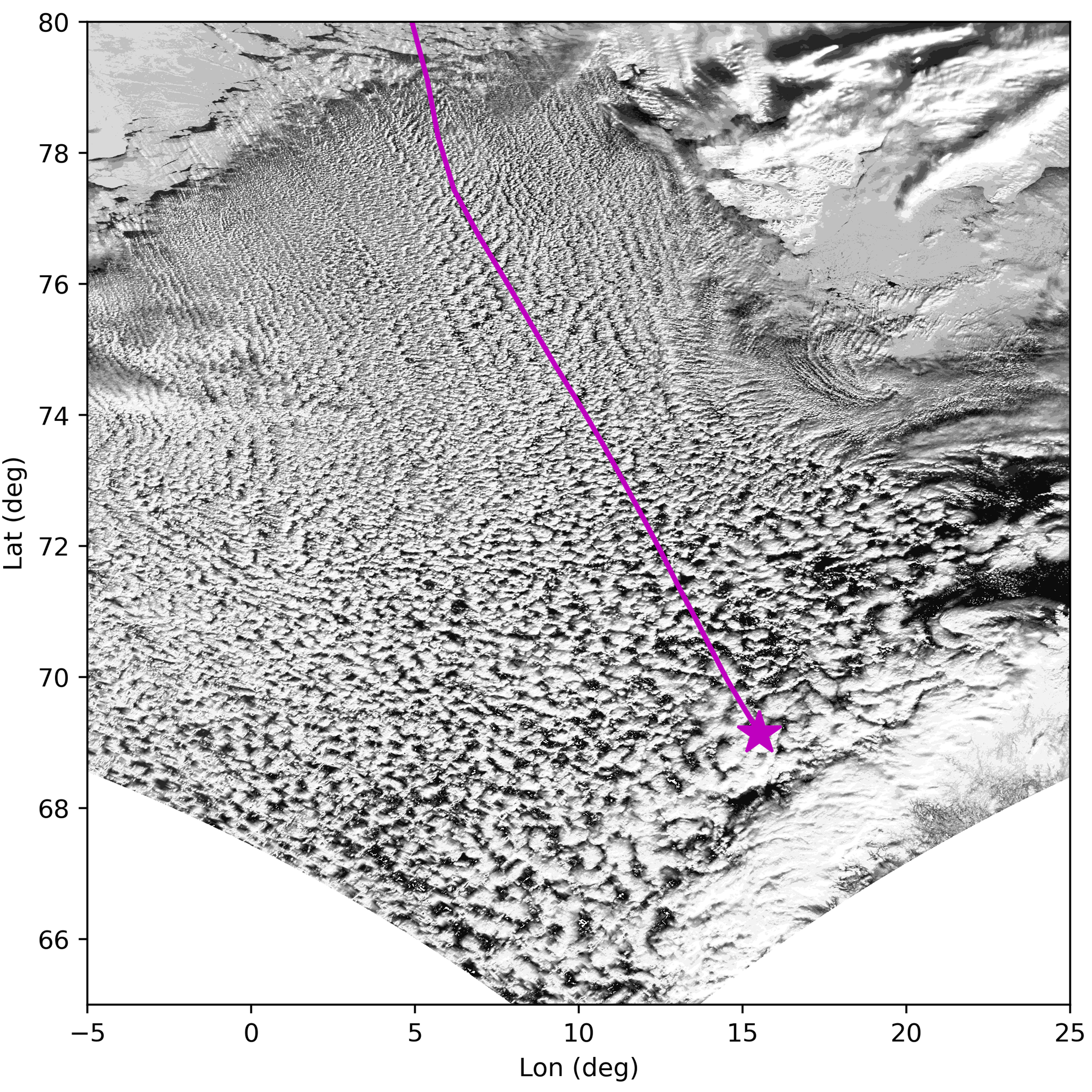Greater ice particle concentrations accelerate cloud breakup
Submitter
Fast, Jerome D
— Pacific Northwest National Laboratory
Area of Research
Cloud Processes
Journal Reference
Wu P, M Ovchinnikov, H Xiao, C Lackner, B Geerts, F Tornow, and G Elsaesser. 2025. "Effect of Ice Number Concentration on the Evolution of Boundary Layer Clouds During Arctic Marine Cold‐Air Outbreaks." Journal of Geophysical Research: Atmospheres, 130(3), 10.1029/2024JD041282.
Science

An image from the Moderate Resolution Imaging Spectroradiometer (MODIS) satellite showing visible reflectance during a marine cold-air outbreak. This phenomenon is a key factor in controlling the air-sea interaction, and cloud formation during these events tends to have a mix of liquid and ice. The magenta line shows the air parcel trajectory toward Andenes, Norway (marked by the star). The model domain moves along the trajectory in this study. Figure from Wu et al. (2025).
Impact
MCAO clouds are strongly forced by heat fluxes from the ocean surface, and it has been reported that atmospheric dynamics govern the transition in cloud patterns. Earlier studies show that metrics based solely on dynamics cannot always predict cloud regimes. Representing these clouds in atmospheric and Earth system models is challenging, primarily because the cloud sizes are usually smaller than the grid sizes of most large-scale models. This study found that the transition in cloud patterns happens earlier with more ice particles present in the clouds.Summary
MCAOs are a key pathway of heat loss in the Arctic Ocean through the convective boundary layer that clouds form and evolve. Understanding the factors that control MCAO cloud transformation is crucial for enhancing their representation in Earth system models. This study used large-eddy simulations to explore how cloud ice number concentrations influence cloud evolution using a case from the Cold-Air Outbreaks in the Marine Boundary Layer Experiment (COMBLE) campaign. The simulations, conducted within a Lagrangian framework following an air mass trajectory, were driven by European Center for Medium-Range Weather Forecasting (ECMWF) atmospheric reanalysis (ERA5) data.
Clouds with a higher number of ice particles were found to start precipitating sooner and break up faster than those with fewer ice particles. Evaporation from precipitation was more pronounced with elevated ice concentrations, resulting in greater stability of the boundary layer and diminished intensity of vertical mixing between the surface and the cloud layer. An increased sink of moisture in the cloud layer due to precipitation, combined with a reduced source from decreased vertical transport, led to an earlier breakup of clouds in conditions with higher ice number concentrations. This work highlights the significance of accurate representations of ice processes in simulating MCAO clouds. It also emphasizes the necessity for observational constraints on ice-nucleating particles and cloud ice number concentrations within mixed-phase cloud regimes.
Keep up with the Atmospheric Observer
Updates on ARM news, events, and opportunities delivered to your inbox
ARM User Profile
ARM welcomes users from all institutions and nations. A free ARM user account is needed to access ARM data.


















